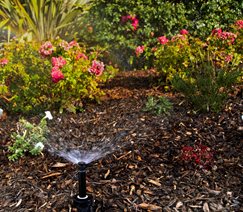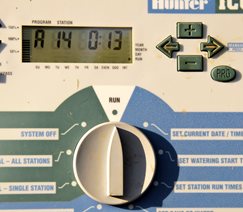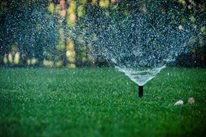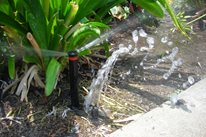Glossary of Sprinkler Terms
Learn the lingo used by sprinkler pros

A fan spray head sprays water in a fixed direction and does not move back and forth. It usually has a finer spray than a rotor head.
Communication with your irrigation contractor will be easier when you understand the basic terms used in the business:
ABSORPTION RATE (or Percolation Rate): The rate at which your soil will accept water. Rate decreases as soil "capacity" is reached. On clay soils it is often better to "session-irrigate" (several shorter watering sessions one hour apart) to reduce run-off and improve absorption of water.
ANTI-SIPHON VALVES: Sprinkler valves that introduce an air gap and prevent siphoning of water. This protects your home's drinking water from back flow thru the sprinkler system.
APPLICATION RATE: The rate at which water is applied by sprinkler heads. It is usually measured in inches per hour or gallons per hour/gallons per day.
ARC: The degree of coverage of a sprinkler from one side of pattern to the other. A 90 degree arc would provide a quarter circle sprinkler pattern.
BACKFLOW PREVENTER: The backflow preventer keeps irrigation water from getting sucked back into the water pipes in your home. This is critically important because without it, pesticides or fertilizer used on your lawn could mix with your drinking water.
BLOW OUTS: In cold climates, your landscaper should come to your home before the first hard freeze to do a “blow out”. They hook an air compressor up to the irrigation system and blow out all of the water in the system so it can’t freeze and damage the pipes or heads.
CYCLE: The slow application of water to the specific root zone area of the plant material using very low pressure.
DRIP IRRIGATION: The slow application of water to the specific root zone area of the plant material using very low pressure.
EVAPORATION: The natural process of changing water into vapor. The warmer the weather, the quicker evaporation takes place.
EVAPOTRANSPIRATION: The combination of evaporation and transpiration from plant material. This is often referred to as the "ET" rate. Some local newspapers will post this rate. Run your sprinklers often enough and long enough to match the "ET" rate to keep plantings healthy.
FAN SPRAY HEAD: A fan spray head sprays water in a fixed direction and does not move back and forth. It usually has a finer spray than a rotor head.
FIXED RISERS: Sprinkler head nozzles mounted on fixed nipples 2-12 inches high. Best used in planter areas as pop-up heads sometimes get stuck in the groundcover and can't pop back down. Use an alternated pattern for watering planter areas, because growing plants often block sprinkler coverage.
HEADS: A sprinkler head is the mechanical part of your system which sprays water across the landscape. It may pop up or be held aloft on a riser.
HEAD-TO-HEAD COVERAGE: As sprinkler heads get to the end of their reach, they spray a finer and finer mist. That’s why contractors aim to provide head-to-head coverage, which is when the spray pattern of sprinkler heads overlap and spray from one head to another. This ensures your lawn is evenly watered.
LOW VOLTAGE CONTROL WIRES: The wires which transmit the signals to open and close from the automatic controller to the automatic electric valves. Because they are low voltage they can be directly buried without conduit. Usually color-coded to ease with installation and wiring in the timer control box.
MAIN LINE: The pipe that runs water utility from street to house and from house to sprinkler manifolds (where the sprinkler valves are located). Main water lines are under constant pressure. Water main lines should be buried a minimum of 18 inches deep (check local building codes for confirmation in your area).
POLY PIPE: Poly pipe is flexible, but it’s also less sturdy than PVC and restricts water flow. Can be advantageous in situations where flexibility is helpful, such as on slopes or in areas where tree roots make digging a straight line impossible. However, it’s a lower-quality material, so should only be chosen over PVC in situations where it’s necessary.
POP-UPS: Sprinkler head bodies with spring actuated nozzles that pop up 3-4 inches above the grade when under water pressure, and then drop back down when the sprinklers are turned off. These types of heads are best used in lawn areas and also in planter areas along walkways to reduce tripping hazards.
PVC PIPE: PVC pipe is hard, inflexible pipe that’s usually used underground to provide water to your sprinkler heads. Because it isn’t flexible, it can only be used in straight lines. Schedule 40 is the grade most contractors choose.
ROTOR SPRAY HEAD: A rotor head moves from side to side, and usually sprays in large droplets or a stream.
START-UPS: This is a spring check-up for your irrigation system. After months of not being used, it’s a good idea to take the time to evaluate your irrigation system for leaks, breaks, or inefficiencies.
TIMER: The timer is usually hard wired to your home, and directs the irrigation system to turn on and off at pre-determined intervals. Can connect to a water sensor for fully automated operation.
VALVE: The valves are wired to the timer and connected to the water pipes, so upon getting the electrical signal from the timer to come on, they open and allow water to flow through the system. Valves are often housed in a green plastic box underground.
WATER SENSOR: This device senses the precipitation in the air and adjusts the irrigation system accordingly so it only runs when needed. While it’s a little more money at the outset, you’ll recoup the cost quickly in water savings.
ZONE or HYDROZONE: A zone is simply a section of your watering system. Because of issues such as water pressure or flow, different sections of your lawn may be set to come on at different times to ensure there’s enough water to provide even coverage. Usually, each zone waters in turn until all zones have completed their cycle.
Glossary terms contributed from these landscape contractors:
- Scott Cohen of The Green Scene in Northridge, CA
- Rick Evans of Aesthetic Gardens in Mountain View, CA
- Andy Villaescusa of A-Plus Sprinkler and Landscape in Crestline, CA
- Jeremy Walla of Aspen Ridge Lawn and Landscape in Rapid City, SD
Learn how to save water and have a thriving lawn
Get an overview of the sprinkler installation process
Get seasonal sprinkler care tips from the pros
Return to Sprinkler Systems




 Watering Tips
Watering Tips Sprinkler Installation
Sprinkler Installation Maintenance & Repair
Maintenance & Repair

